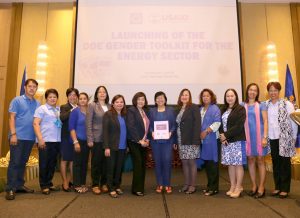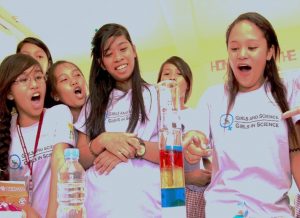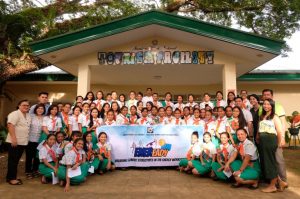
The DOE Gender Toolkit primarily aims to provide DOE, its bureaus, attached agencies, and offices with guides and reference materials on how to make their operations and programs more aware of, and responsive to, the gender concerns of their internal and external clients.
The toolkit consists of four parts. The first presents the gender and development (GAD) strategic framework for DOE, which affirms the Department’s role in recognizing, protecting, promoting, and fulfilling the right of women and men to equal opportunities and participation in the energy sector. The framework also adopts gender mainstreaming as an overarching strategy for realizing the Department’s GAD vision and mission. It recognizes, however, that temporary measures may be needed to improve the access of women and marginalized groups to energy resources, products, and decision-making processes. These are captured in the Department’s GAD goals and in the summary GAD Agenda for 2015–2020.
The second part focuses on how to integrate the twin GAD goals of gender equality and women’s empowerment in energy-sector policies, plans, programs, and projects. The guide encompasses the broad areas of energy-sector policies and planning but covers in greater detail the key stages of program or project development: stakeholder consultations, definition of the energy-sector development problem, and design of the intervention. Gender integration requires attention to the different concerns at each stage. Design of stakeholder consultations should enable the participation of women and women’s groups and capture the voice of women and other hitherto unheard groups. The identification of relevant gender issues and concerns should be a critical part of the situational analysis, the definition of the development problem, and the review of the designed project. Finally, project purpose, outcomes, outputs, activities, and inputs should involve resolving gender issues or achieving results that would contribute to the realization of DOE’s GAD goals.
The GAD checklist for the energy sector constitutes the third part of the toolkit. It summarizes the discussions in the second part and offers a checklist box for rating the gender sensitivity or responsiveness of the design of energy-sector programs or projects.
The fourth part takes up concerns around mainstreaming a gender perspective and integrating GAD goals in the main business of DOE and its bureaus, attached agencies, and offices. The guide draws heavily from the Gender Mainstreaming Evaluation Framework (GMEF) of PCW. While the second and third parts center on client-level gender issues, the GMEF is used to ascertain the level of an agency’s gender mainstreaming efforts and identify organization-focused issues that need to be addressed to make progress.
The full publication of DOE Toolkit for the energy sector can be downloaded at https://www.doe.gov.ph/sites/default/files/pdf/doe_gad/doe_gad_toolkit.pdf.
Girls and Science, Girls in Science
As a responsible advocate of women empowerment, DOE embarked on its gender mainstreaming journey in 1996. One of its early initiatives was to create its GAD-National Focal Point (NFP), also known as GAD Focal Point System (GAD-FPS). In 2011, the GAD-NFP launched an innovative project, “Girls and Science, Girls in Science,” which seeks to encourage third- and fourth-year high school girls from selected science schools to enroll in courses related to the geosciences, engineering, and related disciplines. In 2013, this project gained ground in some parts of the country, opening various opportunities for female students to pursue science courses. It could thus serve as a first step in increasing the future supply of female engineers, geologists, and the like.
With more projects lined up in the coming years, the GAD-NFP or GAD-FPS continues to beef up its efforts to provide equal opportunities to women and men not only in the workplace and DOE attached agencies but also in all DOE partners and stakeholders that are genuinely committed to mainstreaming gender in their plans and programs.

ENEReady
The DOE ENEReady program, launched in 2016, spearheaded by the DOE Consumer Welfare and Promotion Office (CWPO), has now reached more than 3,000 students.
This program seeks to encourage our youth, regardless of their gender, to pursue their career in the field of science, technology, and engineering. Part of securing the energy needs is ensuring that the industry is abundant with capable and competent professionals.
The DOE team, composed of young geologists, petroleum and electrical engineers, introduced the challenging and exciting jobs in the energy sector. The resource persons shared their experiences in the field and the practical lessons which emanated from their wise choice of college courses. They explained their responsibilities in the upstream (exploration, drilling, extraction, and production) to downstream (transmission, distribution, and utilization) energy sector activities.

For more Gender and Development activities, please visit https://www.doe.gov.ph/search/node/Gender%20and%20Development.